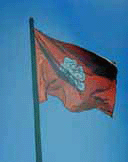
Ascanius; or, the Young Adventurer
Bestselling book of the 18th and 19th centuries
| View the book |
| About the book |
| Le du Teillay |
| Culloden |
| Links |
| Highlanders |
| Related events |
Books |

| Charles Edward Stuart |
You are about to read one of the most amazing books ever written. This book remained in print for over 150 years from 1746 until at least 1899 Aberdeen University - MacBean Collection and went through no fewer than twenty-one editions as observed in “Notes and Queries - 1923 s12-XII: 172” by P. J. ANDERSON. The collection was donated in 1919 by William MacBean LL. D. (1852-1924) of Yonkers, New York (a native of Nairn), to the University of Aberdeen. Five more were noted by Dr. Blaikie and two more found in the British museum. It was even reprinted in 1974 and attributed to John Burton as part of the “Flowering of the Novel” series (actually Ralph Griffiths’ 1746 63pp pamphlet). There is an 1899 version printed by Robert King of Aberdeen. Several factors contributed to its success:
Attributed to Dr. Ralph Griffiths, editor of “The Monthly Review”. However, he could have been protecting his source Neil MacEachen as suggested by Robert Chambers. Although, Don C. Shelton offers compelling arguments that both Alexis and Ascanius (and many similar pamphlets) were written by Tobias Smollett. John Burton M.D. of York was arrested on his return home after meeting with the Rebels. He was held at York Castle and then taken to London where he spent time at the house of William Dick, a Court Messenger. He was examined at Whitehall on 7 May, 1746 by Andrew Stone, the first Secretary to the Duke of Newcastle. In 1749 he published British Liberty Endanger’d. In 1758 he published Monasticon Eboracense and the ecclesiastical history of Yorkshire. |
| Bonnie Prince Charlie | ||
|
|
||

